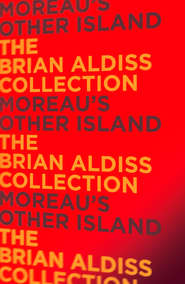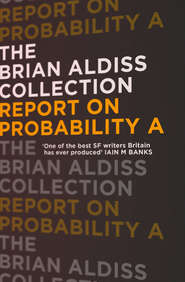По всем вопросам обращайтесь на: info@litportal.ru
(©) 2003-2025.
✖
Collected Essays
Настройки чтения
Размер шрифта
Высота строк
Поля
Even today, when our diet is the unlikely, Mary Shelley’s Frankenstein seems extremely far-fetched; how much more so must it have appeared on publication in 1818. Yet Beard’s girlfriend puts her finger on one of the contradictions which explain the continued fascination of Frankenstein. It seems to know a lot about life, whilst being preoccupied with death.
A preoccupation with death was undoubtedly an important strand in the character of the author of Frankenstein. Marked by the death of her mother in childbirth, she was haunted, at the time of writing Frankenstein, by precognitive dreads concerning the future deaths of her husband and children. By embodying this psychic material into her complex narrative, she created what many regard as that creature with a life of its own, the first SF novel.
Of course, it is a mongrel novel. But modern SF/fantasy is at its best when, like a mongrel, it runs barking down the road of present-day imagination. It’s a mongrel art.
Frankenstein is generically ambivalent, hovering between novel, Gothic, and science fiction. To my mind, precisely similar factors obtain even today in the most celebrated SF novels. Heinlein’s Stranger in a Strange Land contains magic; Anne McCaffrey’s dragon novels hover between legend, fairytale, and science fiction. Is Greg Bear’s Blood Music nanotechnological or allegorical? ‘Pure’ science fiction is chimerical. Its strength lies in its hybrid nature.
Where the central strength of Frankenstein lies is hard to say. We may admire the paintings of Picasso and feel intensely for them without knowing precisely why; some things lie beyond analysis. But just as many Picasso canvasses betray his ferocious anger, so a similar emotion burns in the darkness of Mary Shelley’s pages. She rails against the injustice of the world.
The elements of fairy story are here; ‘Red Riding Hood and the Wolf’ comes to mind. Here are the same dark irrational codes: sex, death, domination, secrecy. Our fear of the monster fights with our pity, as our sympathy for Victor must struggle against our dislike of him. Will the wolf eat Red Riding Hood—or she him? What exactly is the disastrous nature of the relationship between Victor and his creature, that it must be fought out in the wild places of the earth?
The events of Mary Shelley’s life (1797–1851) crowd into the early years. Many transactions that would mould her character occur before she was born.
Her parents both played important roles in the intellectual life of the time. William Godwin was a philosopher and political theorist, whose most important work is An Enquiry Concerning the Principles of Political Justice (1793). Godwin wrote novels as a popular means of elucidating his thought, the most durable being Caleb Williams (1794), which can still be read with interest and excitement. The influence of both these works on Godwin’s daughter’s writing is marked.
Mary Wollstonecraft wrote the first feminist tract, A Vindication of the Rights of Woman (1792). She came to the marriage with Godwin bringing little Fanny Imlay. Distracted by the failure of her love for Gilbert Imlay, Mary had tried to commit suicide by jumping into the Thames off Putney Bridge. Surviving to marry Godwin, she bore him a daughter, Mary, only to die ten days later.
Godwin remarried. His second wife, Mrs Mary Jane Clairmont, brought with her two children by her previous liaison, Charles and Jane. Jane later preferred to be known as Claire. She bore Byron an illegitimate child, Allegra. Fanny and Mary, four years old when Godwin remarried, were further upset by the arrival of this new stepmother into their household. Alienation was no doubt increased when Godwin’s new wife bore him a son. The five children crowding into one house increased Mary’s feeling of isolation. Isolation is the refrain which sounds throughout her novels and short stories. Another constant refrain, that of complex familial relationships, derives from that confused childhood. Of the five children, no two could muster two parents in common, Charles and Jane excepted.
Mary grew to be an attractive woman. Her reserved manner hid a deep vein of feeling, baffled by her mother’s death and her father’s distance. The two kinds of coldness, one might say, are both embodied in her monster’s being in a sense dead and also unloved. When Shelley arrived on the scene he received all her love, and Mary remained faithful to him long after his death, despite his frequent neglect of her.
My dearest Mary, wherefore hast thou gone
And left me in this dreary world alone?
So said Shelley. In fact, the reverse was true.
The product of two intellectuals, Mary Shelley was a blue-stocking, and through many years maintained an energetic reading programme, teaching herself several foreign languages. She had the good fortune to meet in childhood many of the celebrated intellectuals and men of letters of the time, Samuel Taylor Coleridge among them. Trelawny said of her that ‘her head might be put upon the shoulders of a Philosopher’.
Percy Bysshe Shelley, poet and son of a baronet, was an emotional and narcissistic youth. Before his twenty-second birthday, the pair had eloped to France, taking Jane Clairmont—soon to be Claire—with them.
Europe! What freedom it must have represented to Mary, after her sixteen circumscribed years, and what brilliant companionship Shelley must have offered. The youthful travellers were among the first to enter France after the Napoleonic Wars, and a desolate place they found it, fields uncultivated, buildings and villages destroyed. On the way to Switzerland, Shelley wrote to invite his wife Harriet, now pregnant with Shelley’s second child, to join the party. Before they reached Lake Lucerne, Mary knew that she also was pregnant.
Catastrophe followed the lovers. Mary’s child, a daughter, was born after they returned to London and their debts. She was premature and died. A second child, William, scarcely fared better. In the summer of 1816, Shelley and Mary went to Switzerland again, taking along William and, inevitably, Claire Clairmont. They found accommodation at the Maison Chapuis, on the shores of Lake Geneva, next to the Villa Diodati, where Lord Byron was staying. Claire threw herself at Byron’s head, and managed to encompass the rest of him. It was a creative time for them, with philosophy and learning pursued, as well as the more touted facets of the good life. It was here that Mary began to write Frankenstein. She was eighteen. Summer had too short a stay, and the party returned to England to face more trouble.
Mary’s self-effacing half-sister, Fanny, committed suicide with an overdose of laudanum at the age of twenty two. The Shelley ménage had moved to the West Country. Claire still followed them, as the monster followed Frankenstein. She was now pregnant by Byron. Then news reached them that Shelley’s wife Harriet had drowned herself in the Serpentine, when far advanced in pregnancy. Shelley and Mary married almost immediately.
The date of the marriage was 29 December 1816. Five and a half years later, in July 1822, Shelley drowned whilst sailing on the Ligurian Sea. By that time, the little boy, William, was dead, as was another child, Clara. Mary had also had a miscarriage. A further son, Percy Florence, was born. He alone of Mary’s progeny survived to manhood. Even Claire’s daughter by Byron, the little Allegra, died in Italy.
The rest of Mary Shelley’s life is lived in the shadow of her first twenty-five years. After Byron died in Greece in 1824, both the great poets were gone. Mary remained ever faithful to the memory of her husband. She edited his poems and papers, and earned a living by her pen. Frankenstein, published in 1818, became immediately popular. She also wrote historical novels, such as Perkin Warbeck (1830), Lodore (1835) which enjoyed some success, travel journals, short stories, and a futuristic novel, The Last Man (1826) which, by its powerfully oppressive theme of world catastrophe, is classifiable as science fiction. Percy married. Her cold father, Godwin, died; Shelley’s difficult father died. Finally, in 1851, the year of the Great Exhibition, Mary herself died, aged fifty-three.
This painful biography, as confused as any modern one, helps to explain why Mary Shelley’s temperament was not a sanguine one. From it derives much of what we read in her two science fiction novels, Frankenstein and The Last Man. As do all novels, both owe a great deal to the literature that preceded them. Much is owed to experience. Critics are liable comfortably to ignore the latter to concentrate on the former.
The essence of the story of Frankenstein is familiar, if in distorted form, from many film, stage and TV versions; Victor Frankenstein constructs a creature from corpses and then endows it with life, after which it runs amok. The novel is more complex than this synopsis suggests.
Some of its complexities have recently been explored by Marilyn Butler in her exemplary edition of the novel (see Bibliography). Butler examines the work of scientists who were influential, in particular the avant-garde William Lawrence. Something of the disputes of the time regarding the role of mind, physical sciences, and the irrational, are preserved in Frankenstein’s three narrators, Walton, Victor, and the creature. In the same way, modern SF novels contain debates about the future of Artificial Intelligence, and whether AI will prove beneficial or otherwise.
Butler presents the 1818 text, with convincing arguments as to why it is to be preferred to the hitherto more popular 1831 text. The latter was toned down in many aspects, to make it more acceptable in a conformist age. Mary Shelley had to live by her pen, in a harsh society well depicted in William St Clair’s biography (see Bibliography). Besides, that one surviving son of hers was to become a baronet …
Frankenstein: or, The Modern Prometheus begins with letters from Captain Walton to his sister. Walton is sailing in Arctic waters when he sees on the ice floes a sledge being driven by an enormous figure. The next day, the crew rescue a man from a similar sledge. It is Victor Frankenstein of Geneva. When he recovers, he tells Walton his tale. This account takes up the bulk of the book, to be rounded off by Walton again. Six chapters give the creature’s own account of its life, especially of its education. If the style of the novel is discursive, Mary Shelley was following methods familiar to readers of Richardson and Sterne. It became unfashionable but—to readers of eccentric modern novels—is now increasingly sympathetic and accounts in part for the new-found popularity of the novel.
Most of the drama is set not in the seamy London Mary Shelley knew from her childhood, but amid the spectacular Alpine scenery she had visited with Shelley. The puissance of Frankenstein’s creature gains greatly by its association with the elements—storm, cold, glaciers, desolation.
Interest has always centred on the monster and its creation. In the novel it has no name, being referred to as ‘creature’, ‘daemon’, or ‘monster’. This accounts in part for the popular misusage by which the name Frankenstein has come to be transferred from the creator to the created—a mistake occurring first in Mary’s lifetime. The roles of the two chief protagonists also become interchangeable. The essential SF core of the narrative is the experiment which goes wrong. This prescription is to be repeated later, many times, in Amazing Stories and elsewhere.
Victor Frankenstein’s is a Faustian dream of unlimited power, but this Faust makes no supernatural pacts; he succeeds only when he throws away the fusty old reference books, outdated by the new natural philosophy, and gets to work on research in laboratories. Paracelsus out, Science in.
This is the new perception. This is the revolt of Shelley’s generation. Kick out the old laws. Kick the Ottomans out of fair Greece. Get rid of those old spells. The new formulae of science, of a new age, have more power—even the power of life over death.
Mary Shelley in her Journals speaks of a tyrannical buried life she was forced to lead, ‘an internal life quite different from the external one’. It is a revealing remark—and not an uncommon discomfort. For our hopes themselves come trailing a shadow side. And with the bold new experiments designed to change the world, a bill is always presented. Victor Frankenstein himself begins work with what are, on the surface, the best of motives. ‘What glory would attend the discovery’, he says in Chapter II, ‘if I could banish disease from the human frame, and render man invulnerable to any but a violent death!’
But SF is not only hard science. Related to the first core is a second, also science-fictional, the tale of an experiment in political theory which relates to William Godwin’s ideas. Frankenstein is horrified by his creation and abjures responsibility. Yet the monster, despite its ugliness, is gentle and intelligent, and tries to win its way into society. Society repulses it. Hence the monster’s cry, ‘I am malicious because I am miserable’, a dramatic reversal of Christian thinking of the time.
The richness of the story’s metaphorical content, coupled with the excellence of the prose, has tempted commentators to interpret the novel in various ways. Frankenstein’s subtitle, The Modem Prometheus, points to one level of meaning. Prometheus, according to Aeschylus in Prometheus Bound, brings fire from Heaven and bestows the gift on mankind; for this, Zeus has him chained to a rock in the Caucasus, where an eagle eats his viscera.
Another version of the legend, the one Mary Shelley had chiefly in mind, tells of Prometheus fashioning men out of mud and water. She seized on this aspect of the legend, whilst Byron and Shelley were writing Prometheus and Prometheus Unbound respectively. With an inspired transposition, she uses electricity as the divine fire.
By this understanding, with Frankenstein acting God, Frankenstein’s monster becomes mankind itself, blundering about the world seeking knowledge and reassurance. The monster’s intellectual quest has led David Ketterer, in Frankenstein’s Creation: The Book, The Monster and Human Reality (University of Victoria, 1979), to state that ‘basically Frankenstein is about the problematical nature of knowledge’. Though this interpretation is too radical, it reminds us usefully of the intellectual aspects of the work, and of Mary’s understanding of the British philosophers, Locke, Berkeley and Hume.
Leonard Woolf, in The Annotated Frankenstein,
argues that Frankenstein should be regarded as ‘psychological allegory’. This view is supported by David Ketterer, who thinks that therefore the novel cannot be science fiction. Godwin’s Caleb Williams is also psychological, or at least political allegory; it is nevertheless regarded, for example by Julian Symons in his history of the detective novel, Bloody Murder,
as the first crime novel. Many good SF novels are psychological allegory as well as being science fiction. Algis Budry’s Who? is an example.
By understanding the origins of ‘real’ science fiction, in which humanity seizes on new powers, we understand something of SF’s function; hence the importance of the question. Not to regard Frankenstein but, say The Time Machine or even Gernsback’s 1920’s magazines as the first SF—as many did only a few years ago—is to underestimate the capabilities of the medium. Alternatively, to claim that Gilgamesh or Homer or the satirical Lucian of Samosata started it all is to claim that almost anything is SF.
Mary Shelley wanted her story to ‘speak to the mysterious fears of our (i.e. humankind’s) nature’ … Is that not what SF still excellently does—or can do, for instance in Rob Holdstock’s Mythago Wood?
No doubt the novel gave voice to Mary Shelley’s own mysterious fears. What makes our flesh creep is not Boris Karloff or Christopher Lee in funny make-up, but the terror that there may be an enemy trapped within ourselves, waiting to leap out and betray us. This was the tyranny of Mary’s inner life. It was also the tyranny inherent in another scientific experiment, written later in the century, Robert Louis Stevenson’s Dr Jekyll and Mr Hyde (1886).
[Jekyll] thought of Hyde, for all his energy of life, as of something not only hellish but inorganic. This was the shocking thing: … that what was dead, and had no shape, should unsurp the offices of life.
In his book, In Frankenstein’s Shadow (OUP, 1987), Chris Baldick speaks of Stevenson’s short novel as ‘the clearest presentation of Victorian writers’ concern with ‘‘the divided self”. Mary Shelley’s fear of further sexual reproduction is embodied on the one hand in Victor, while her rage and loneliness is embodied on the other hand in the creature. But the game is not as simple as that.
That the destructive monster stands for one side of Percy Bysshe Shelley’s nature and the constructive Victor for the other is convincingly argued by another critic, Christopher Small, in Ariel Like a Harpy.
Mary’s passion for Shelley, rather than blinding her, gave her terrifying insight. Mary Shelley herself, in her Introduction to the 1831 edition of her novel, means us to read it as a kind of metaphor when she says ‘Invention … does not consist in creating out of void, but out of chaos; the materials must, in the first place, be afforded: it can give form to dark, shapeless substances, but it cannot bring into being substance itself’.
In referring to Frankenstein as a diseased creation myth (Billion Year Spree, 1973), I had in mind phrases with sexual connotations in the novel such as ‘my workshop of filthy creation’, used by Frankenstein of his secret work. Mary’s experiences showed her life and death closely intertwined. The genesis of her terrifying story came to her in a dream, in which she saw ‘the hideous phantasm of a man stretched out, and then, on the working of some powerful engine, show signs of life, and stir with an uneasy half vital motion’. The words suggest both a distorted image of her mother dying—in those final restless moments which often tantalizingly suggest recovery rather than its opposite—and the stirrings of sexual intercourse. ‘Powerful engine’ is a term which serves in pornography as a synonym for penis.
The critic Ellen Moers, in ‘Female Gothic: The Monster’s Mother’,
disposes of the question of how a girl still in her teens could hit on such a horrifying idea (though the authoress was herself the first to raise it). Most female writers of the eighteenth and nineteenth centuries were spinsters and virgins; Victorian taboos operated against writing about childbirth. Mary experienced the fear, guilt, depression and anxiety which attend childbirth, particularly in situations such as hers, unmarried, her consort a married man with children by another woman, beset by debt in a foreign place. Only a woman, only Mary Shelley, could have written Frankenstein. As Beard’s girlfriend says, ‘She was the only one of the lot of them who knew about life’.
It is commonly accepted that the average first novel relies for its material on personal experience. We do not deny other interpretations—for a metaphor has many interpretations—by stating that Mary sees herself as the monster. This is why we pity it. She too tried to win her way into society. By running away with Shelley, she sought acceptance through love. The move carried her further from society; she became a wanderer, an exile, like Byron, like Shelley, like Trelawny, and Claire Clairmont, who spent many years abroad. Her mother’s death in childbirth must have caused her to feel that she, like the monster, had been born from the dead. Behind the monster’s eloquence lies Mary Shelley’s grief. Part of the continued appeal of the novel is the drama of a neglected child.
Upon this structure of one kind of reality, Mary built a further structure, one of the intellect. A fever for knowledge abounds; not only Frankenstein but the monster and Walton also, and the judicial processes throughout the book, are in a quest for knowledge of one kind and another. Interestingly, the novel contains few female characters (a departure from the Gothic mode with its soft, frightened heroines). Victor’s espoused, Elizabeth, remains always a distant figure. The monster, a product of guilty knowledge, threatens the world with evil progeny.











